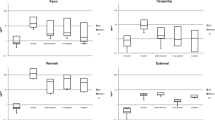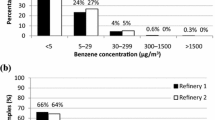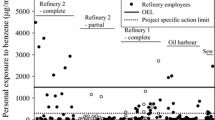Summary
The exposure of workers to methylene chloride and phenol in an aeronautical workshop was measured during stripping of paint from a Boeing B 747. Methylene chloride exposure was measured during two work days by personal air sampling, while area sampling was used for phenol. During paint stripping operations, methylene chloride air concentrations ranged from 299.2 mg/m3 (83.1 ppm) to 1888.9 mg/m3 (524.7 ppm). The exposures to methylene chloride calculated for an 8-h work day ranged from 86 mg/m3 (23.9 ppm) to 1239.5 mg/m3 (344.3 ppm). In another aeronautical workshop, exposure to organic solvents, especially ethylene glycol monoethyl-ether acetate (EGEEA), was controlled during the painting of an Airbus A 320. The external exposure to solvents and EGEEA was measured by means of individual air sampling. The estimation of internal exposure to EGEEA was made by measuring its urinary metabolite, ethoxyacetic acid (EAA). Both measurements were made during the course of 3 days. The biological samples were taken pre-and post-shift. During painting operations, methyl ethyl ketone, ethyl acetate, n-butyl alcohol, methyl isobutyl ketone, toluene, n-butyl acetate, ethylbenzene, xylenes and EGEEA were detected in working atmospheres. For these solvents, air concentrations ranged from 0.1 ppm to 69.1 ppm. EGEEA concentrations ranged from 29.2 mg/m3 (5.4 ppm) to 150.1 mg/m3 (27.8 ppm). For biological samples, the average concentrations of EAA were 108.4 mg/g creatinine in pre-shift and 139.4 mg/g creatinine in post-shift samples. Despite the fact that workers wore protective respiratory equipment during paint spraying operations, EEA urinary concentrations are high and suggest that percutaneous uptake is the main route of exposure for EGEEA. The introduction of new paint stripping processes in the aeronautical industry could help to reduce future exposure to methylene chloride.
Similar content being viewed by others
References
Dugard PM, Walker M, Mawdsley SJ, Scott RC (1984) Absorption of some glycol ethers through human skin in vitro. Environ Health Perspect 57:193–197
Fagin J, Bradley J, Williams D (1980) Carbon monoxide poisoning secondary to inhaling methylene chloride. Br Med J 281:1461
Groeseneken D, Veulemans H, Masschelein R, Van Vlem E (1989) An improved method for the determination in urine of alkoxyacetic acids. Int Arch Occup Environ Health 61:249–254
Hearne FT, Pifer JW, Crose F (1990) Absence of adverse mortality effects in workers exposed to methylene chloride: an update. J Occup Med 32:234–240
IARC (1987) IARC monographs on the evaluation of carcinogenic risks to humans. Supplement 7:194–195
Johanson G, Boman A (1991) Percutaneous absorption of 2-butoxyethanol vapor in human subjects. Br J Ind Med 48:788–792
NIOSH (1991) Criteria for a recommended standard. Occupational exposure to ethylene glycol monomethyl ether, ethylene glycol monoethyl ether, and their acetates. DMHS (NIOSH) publication 91–119
Noordemer H (1992) International Air Transport Association. Taskforce “Paintstripping”. Presented at SURFAIR IX: 9th International Conference on Surface Treatments in the Aeronautical and Aerospace Industries, 3–5 June, Cannes, France
Ott MG, Skoky LK, Holder BB, Bronson JM, William PR (1983) Health evaluation of employees occupationaly exposed to methylene chloride. Scand J Work Environ Health 9:1–38
Putz VR, Johnson BL, Setzer JV (1979) A comparative study of the effects of carbon monoxide and methylene chloride on human performance. J Environ Pathol Toxicol 2:97–112
Shusterman D, Quinlan P, Lowengart R, Cone J (1990) Methylene chloride intoxication in a furniture refinisher. J Occup Med 32:451–454
Vincent R, Cicolella A, Poirot P (1990) Dosage des éthers de glycol dans les atmosphere de travail. Analusis 18:591–596
Winek CL, Collom WD, Esposito F (1981) Accidental methylene chloride fatality. Forensic Sci Int 18:165–168
Author information
Authors and Affiliations
Rights and permissions
About this article
Cite this article
Vincent, R., Poirot, P., Subra, I. et al. Occupational exposure to organic solvents during paint stripping and painting operations in the aeronautical industry. Int Arch Occup Environ Health 65, 377–380 (1994). https://doi.org/10.1007/BF00383247
Received:
Accepted:
Issue Date:
DOI: https://doi.org/10.1007/BF00383247




